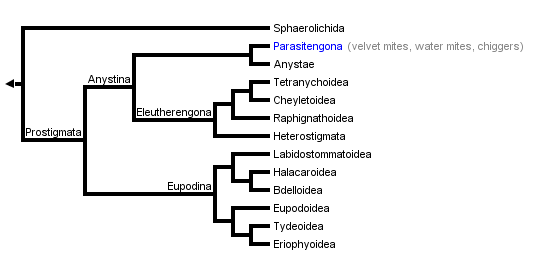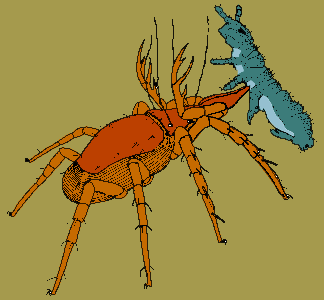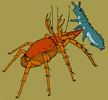Trombidiformes
Trombidiform mites
Heather Proctor


This tree diagram shows the relationships between several groups of organisms.
The root of the current tree connects the organisms featured in this tree to their containing group and the rest of the Tree of Life. The basal branching point in the tree represents the ancestor of the other groups in the tree. This ancestor diversified over time into several descendent subgroups, which are represented as internal nodes and terminal taxa to the right.

You can click on the root to travel down the Tree of Life all the way to the root of all Life, and you can click on the names of descendent subgroups to travel up the Tree of Life all the way to individual species.
For more information on ToL tree formatting, please see Interpreting the Tree or Classification. To learn more about phylogenetic trees, please visit our Phylogenetic Biology pages.
close boxIntroduction
The Trombidiformes is a huge and diverse assemblage of mites, characterized more by the lack of characters found in the other major group of acariform mites (Sarcoptiformes) than by many synapomorphies of their own (Lindquist 1996). It includes some medically important mites (chiggers, scrub itch mites) and many agriculturally important ones. Among the latter are spider mites (Tetranychidae) and gall mites (Eriophyidae). With the exclusion of the Sphaerolichida, the Trombidiformes is also known as the Prostigmata because the openings to the tracheal system are towards the dorsal prosoma of the mite.
Characteristics
According to OConnor (1984), the Trombidiformes are characterized by several charcters that unite the Prostigmata (which makes up the majority of the group) with the Sphaerolychidae and Lordalychidae. These characters are: anamorphic segments AN and PA not added in ontogeny; hysterosomal segment C with fewer than four pairs of setae; and hysterosomal segments D and E with fewer than two pairs of setae. OConnor's cladogram also indicates that the character 'hysterosoma without primary segmentation' is a feature of the Trombidiformes; however, as it also occurs in a number of sarcoptiform taxa, it is not a unique character. Lindquist (1996) notes that most (but not all) members of the Trombidiformes can be differentiated from the Sarcoptiformes by having chelicerae with a hooklike or styletlike movable digit rather than the ancestral chelate form. Likewise, many trombidiform mites have a padlike or rayed median empodium in contrast to the clawlike or disk-shaped empodium of sarcoptiforms. Within the Trombidiformes, the Prostigmata are united by having the stigmatal openings to the tracheal system located anteriorly (e.g. on the prodorsum or near the base of the mouthparts).
Discussion of Phylogenetic Relationships
OConnor (1984) performed a cladistic analysis of the major taxa within the Acariformes and determined that the Sphaerolichida and Prostigmata shared two developmental and two setal characters, while the Prostigmata were united by the presence of anterior openings to the tracheal system. Lindquist (1996) and Norton et al. (1993) provide recent cladograms of taxa within the Prostigmata. As these relationships are based on unpublished analyses, it is difficult to discuss the rationale for linking different taxa; however, Lindquist (1996) does provide a list of characters uniting the superfamily Eriophyoidea.
There are several differences between Lindquist's tree, presented above, and that of Norton et al. (see below). While both divide the Prostigmata into three major groups, the Anystina, Eleutherengona and Eupodina, Lindquist nests the Eleutherengona within the Anystina while Norton et al. present them as completely separate clades:
================== Parasitengona
===|
==Anystina=| ================== Anystidae
| |
| ===================== other Anystina
|
| ================== Labidostommatidae
| |
===| | =============== Eupodoidea
| | ===| |
| | | ===| ============ Tydeoidea
| ==Eupodina=| ===|
| | ============ Eriophyoidea
| |
| | ================== Bdelloidea
| ===|
| = ?== Halacaroidea
=====|
| === Tetranychoidae
| ===|
| ===| === Cheyletoidea
| ===| |
| ===| | ====== Raphignathoidea
| | | |
| | | ========= Pterygosomatoidea
| ===| |
==Eleutherengona=| | ============ Pomerantzioidea
| |
| | ========= Pseudocheylidae
| | ===|
| ===| ========= Heterostigmata
| |
| ============ Stigmocheylidae
|
================== Paratydeidae
Other differences are that Norton et al. shift Bdelloidea and Halacaroidea to the base of the Eupodina, and depict the Parasitengona as relatively derived within the Anystina. Finally, Norton et al. have moved a number of groups typically considered to belong to the Anystina (Pterygosomatoidea, Pomerantzioidea, Pseudocheylidae, Paratydeidae and Stigmocheylidae) to the Eleutherengona; however, they do not provide the rationale for this restructuring.
References
Lindquist, E.E. 1996. Phylogenetic relationships. pp. 301-327 in: E.E. Lindquist, M.W. Sabelis and J. Bruin (eds.) Eriophyoid mites - their biology, natural enemies and control. Elsevier Science, Amsterdam.
Norton, R.A., J.B. Kethley, D.E. Johnston, and B.M. OConnor. 1993. Phylogenetic perspectives on genetic systems and reproductive modes of mites. pp. 8-99 in: D.L. Wrensch and M.A. Ebbert (eds.) Evolution and diversity of sex ratio in insects and mites. Chapman & Hall, New York.
OConnor, B.M. 1984. Phylogenetic relationships among higher taxa in the Acariformes, with particular reference to the Astigmata. pp. 19-27 in D.A.
Griffiths and C.E. Bowman. 1984. Acarology VI, Vol. I. Ellis-Horwood Ltd., Chichester.
Title Illustrations

Cunaxa (Cunaxidae) feeding on a springtail (Collembola). Drawing copyright © 1998 H.Proctor & D.Walter.
| Copyright |
© 1998 Heather Proctor

|
|---|
About This Page
Heather Proctor

University of Alberta, Edmonton, Alberta, Canada
Correspondence regarding this page should be directed to Heather Proctor at
Page copyright © 1998 Heather Proctor
 Page: Tree of Life
Trombidiformes. Trombidiform mites.
Authored by
Heather Proctor.
The TEXT of this page is licensed under the
Creative Commons Attribution License - Version 3.0. Note that images and other media
featured on this page are each governed by their own license, and they may or may not be available
for reuse. Click on an image or a media link to access the media data window, which provides the
relevant licensing information. For the general terms and conditions of ToL material reuse and
redistribution, please see the Tree of Life Copyright
Policies.
Page: Tree of Life
Trombidiformes. Trombidiform mites.
Authored by
Heather Proctor.
The TEXT of this page is licensed under the
Creative Commons Attribution License - Version 3.0. Note that images and other media
featured on this page are each governed by their own license, and they may or may not be available
for reuse. Click on an image or a media link to access the media data window, which provides the
relevant licensing information. For the general terms and conditions of ToL material reuse and
redistribution, please see the Tree of Life Copyright
Policies.
- First online 12 August 1998
- Content changed 09 August 1998
Citing this page:
Proctor, Heather. 1998. Trombidiformes. Trombidiform mites. Version 09 August 1998. http://tolweb.org/Trombidiformes/2568/1998.08.09 in The Tree of Life Web Project, http://tolweb.org/








 Go to quick links
Go to quick search
Go to navigation for this section of the ToL site
Go to detailed links for the ToL site
Go to quick links
Go to quick search
Go to navigation for this section of the ToL site
Go to detailed links for the ToL site